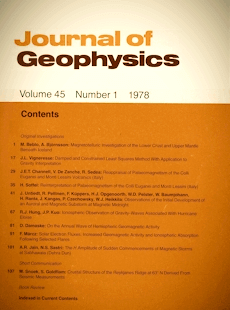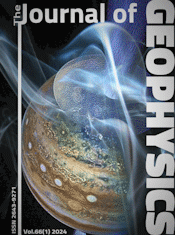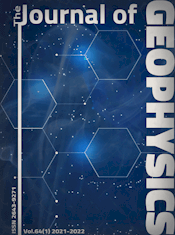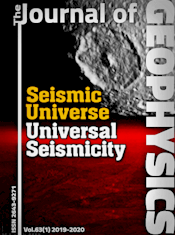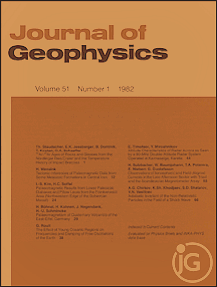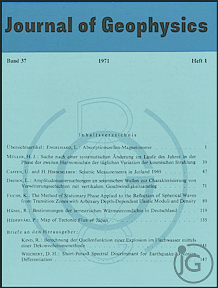Tidal triggering of earthquakes in the Swabian Jura?
Article Sidebar
Published:
Dec 22, 1978
Keywords:
Tidal triggering,
Earthquake statistics,
Swabian Jura
Volumes
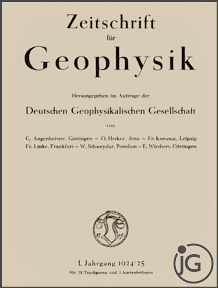
Vols. 1-18 (1924-1944), ISSN 0044-2801
Main Article Content
D. Young
Department of Geodesy and Geophysics, University of Cambridge, UK
W. Zurn
Black Forest Observatory, Karlsruhe University and Stuttgart University, Germany
Abstract
Several statistical tests were used to investigate the possibility that the earthquakes in the Swabian Jura are triggered by the tidal stress in the Earth. The results provide weak evidence that the earthquakes tend to occur when the tidal shear stress on the fault plane in the direction supporting the tectonic stress is greatest. A comparison of some of the statistical methods available for investigating tidal triggering effects is made.
 ARK: https://n2t.net/ark:/88439/y090017
ARK: https://n2t.net/ark:/88439/y090017
Permalink: https://geophysicsjournal.com/article/41
Article Details
How to Cite
Section
References
Beavan, R. (1976) Earth strain: ocean loading and analysis. PhD dissertation, University of Cambridge
Bilham, R., Evans, R., King, G., Lawson, A., McKenzie, D. (1972) Earth strain tides observed in Yorkshire, England, with a simple wire strainmeter. Geophys. J. 29:473-485
Bilham, R., King, G., McKenzie, D. (1974) Inhomogeneous tidal strains in Queensbury tunnel, Yorkshire. Geophys. J. 37:217-226
Dieter, U. (1971) Pseudo-random numbers: the exact distribution of pairs. Math. Comp. 25:855-883
Fisher, R. (1975) Statistical methods for research workers, 14th ed. Edinburgh: Oliver & Boyd 1970
Heaton, T.: Tidal triggering of earthquakes. Geophys. J. 43:307-326
Klein, F. (1976) Earthquake swarms and the semidiurnal solid earth tide. Geophys. J. 45:245-295
Knopoff, L. (1964) Earth tides as a triggering mechanism for earthquakes. Bull. Seism. Soc. Am. 54:1865-1870
Mann, H., Whitney, D. (1947) A test of whether one of two random variables is stochastically larger than the other. Ann. Math. Stat. 18:50-59
Massey, F., Jr. (1951) The Kolmogorov-Smirnov test for goodness of fit. J. A mer. Statist. Ass. 46:68-78
Schick, R. (1968) Untersuchungen tiber die Bruchausdehnung und Bruchgeschwindigkeit bei Erdbeben mit kleinen Magnituden (M < 4). Z. Geophys. 34:267-286
Schneider, G. (1968) Erdbeben und Tektonik in Siidwest-Deutschland. Tectonophysics. 5:459-511
Schneider, G. (1971) Seismizitiit und Seismotektonik der Schwiibischen Alb. Stuttgart: Ferdinand Enke Verlag
Schuster, A. (1897) On lunar and solar periodicities of earthquakes. Proc. Roy. Soc. 61:455-465
Shlien, S. (1972) Earthquake tide correlation. Geophys. J. 28:27-34
Shudde, R., Barr, D. (1977) An analysis of earthquake frequency data. Bull. Seism. Soc. Am. 67:1379-1386
Siegel, S. (1956) Non parametric statistics for the behavioural sciences, international student edition. Tokyo: McGraw-Hill Kogakusha
Bilham, R., Evans, R., King, G., Lawson, A., McKenzie, D. (1972) Earth strain tides observed in Yorkshire, England, with a simple wire strainmeter. Geophys. J. 29:473-485
Bilham, R., King, G., McKenzie, D. (1974) Inhomogeneous tidal strains in Queensbury tunnel, Yorkshire. Geophys. J. 37:217-226
Dieter, U. (1971) Pseudo-random numbers: the exact distribution of pairs. Math. Comp. 25:855-883
Fisher, R. (1975) Statistical methods for research workers, 14th ed. Edinburgh: Oliver & Boyd 1970
Heaton, T.: Tidal triggering of earthquakes. Geophys. J. 43:307-326
Klein, F. (1976) Earthquake swarms and the semidiurnal solid earth tide. Geophys. J. 45:245-295
Knopoff, L. (1964) Earth tides as a triggering mechanism for earthquakes. Bull. Seism. Soc. Am. 54:1865-1870
Mann, H., Whitney, D. (1947) A test of whether one of two random variables is stochastically larger than the other. Ann. Math. Stat. 18:50-59
Massey, F., Jr. (1951) The Kolmogorov-Smirnov test for goodness of fit. J. A mer. Statist. Ass. 46:68-78
Schick, R. (1968) Untersuchungen tiber die Bruchausdehnung und Bruchgeschwindigkeit bei Erdbeben mit kleinen Magnituden (M < 4). Z. Geophys. 34:267-286
Schneider, G. (1968) Erdbeben und Tektonik in Siidwest-Deutschland. Tectonophysics. 5:459-511
Schneider, G. (1971) Seismizitiit und Seismotektonik der Schwiibischen Alb. Stuttgart: Ferdinand Enke Verlag
Schuster, A. (1897) On lunar and solar periodicities of earthquakes. Proc. Roy. Soc. 61:455-465
Shlien, S. (1972) Earthquake tide correlation. Geophys. J. 28:27-34
Shudde, R., Barr, D. (1977) An analysis of earthquake frequency data. Bull. Seism. Soc. Am. 67:1379-1386
Siegel, S. (1956) Non parametric statistics for the behavioural sciences, international student edition. Tokyo: McGraw-Hill Kogakusha


